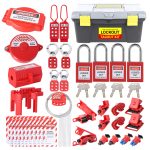
Boosting Workplace Safety: Essential Tools for Effective Lockout/Tagout Programs
July 18, 2022
Building a Safer Workplace: Essential Elements of a Lockout Program
July 19, 2022
Boosting Workplace Safety: Essential Tools for Effective Lockout/Tagout Programs
July 18, 2022
Building a Safer Workplace: Essential Elements of a Lockout Program
July 19, 2022With the rise of Lone Workers operating in diverse and often remote environments, their safety has become a top priority for industrial managers. Whether indoors or outdoors, these workers face unique challenges that demand a comprehensive framework to ensure their well-being.
This guide outlines proactive strategies to establish a secure and healthy environment for Lone Workers, focusing on risk assessment, preparedness, communication, and robust safety protocols.

Laying the Groundwork: Risk Assessment and Hazard Analysis
The cornerstone of Lone Worker safety is a thorough risk assessment. By identifying job-specific hazards, managers can effectively mitigate potential risks. A complementary hazard analysis further pinpoints site-specific dangers, providing a roadmap for action.
This systematic approach allows organizations to integrate essential health and safety measures tailored to the unique demands of each task. Crucially, these measures prepare Lone Workers for emergency scenarios, ensuring they are equipped to respond effectively.
Empowering Lone Workers Through Training and Preparedness
Risk identification alone isn't enough. Lone Workers must be empowered with targeted training that addresses the challenges they may encounter. A training needs analysis bridges the gap between general safety education and the specific requirements of their roles.
Regular refresher courses and inspections are equally important. Equipment should be evaluated to confirm its suitability for single-person use, and first aid kits should be customized to address potential emergencies in isolated conditions.
Communication: The Lifeline for Lone Workers
Maintaining consistent communication is critical to Lone Worker safety. Regular check-ins—whether hourly, verbal, or in person—help ensure their well-being.
Providing workers with reliable communication tools, such as smartphones, satellite phones, or GPS-enabled devices, enhances their ability to stay connected. Advanced safety apps that alert authorities and share precise locations add an extra layer of security, while audible alarms serve as practical and immediate safety measures.
Building a Strong Lone Worker Protocol
An effective Lone Worker safety protocol should include:
- Risk Assessment Expertise: Training managers and staff to conduct comprehensive risk assessments.
- Robust Safety Procedures: Implementing strategies to mitigate risks and respond to incidents.
- Collaborative Management: Sharing responsibilities for optimal security and support.
- Clear Information Sharing: Ensuring accountability and proper communication within the organization.
- Advanced Training Programs: Focusing on both preventive and reactive safety measures.
Regular reviews and updates to these protocols are essential to keep pace with evolving risks and ensure ongoing protection for Lone Workers.
Partner with EZSecur for Industrial Safety Solutions
At EZSecur, we specialize in products and signage solutions designed to enhance workplace safety. Trust us to help you build a safer environment for your Lone Workers. Visit www.ezsecur.com for more information.





